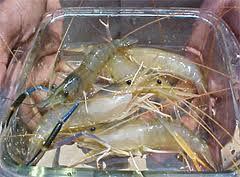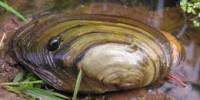Freshwater prawn farming in Bangladesh:
Introduction
Bangladesh is considered as one of the most suitable country in the world for freshwater prawn (golda chingri) due to its climatic conditions. There are twenty-four species of freshwater prawn are found in Bangladesh. However only M. rosenbergii has aquaculture potential and is commercially cultured. A sub-tropical climate and a vast area of water bodies provide a unique opportunity for the production of Macrobrachium spp. Twenty-four species of freshwater prawns including 10 species of Macrobrachium are found in Bangladesh (Table 1). However, only M. rosenbergii has significant aquaculture potential and is commercially cultured (Akand & Hasan1992; Ahmed 2001; Muir 2003a).
Freshwater prawn (M. rosenbergii) farming is currently one of the most important sectors of the national economy and during the last two decades, its development has attracted considerable attention because of its export potential. The prawn and shrimp sector as a whole is the second largest export industry after readymade garments, generating US$380 million annually and 5.6% of the total value of exports [Department of Fisheries (DOF) 2006]. There are 1.2 million people employed in prawn and shrimp production and a further 4.8 million household members are associated with the sector (USAID 2006). Unfortunately the export value and the number of people involved in prawn farming is not known because statistics often do not distinguish between prawn and shrimp. Despite the growth of this sector, a number of issues are important for freshwater prawn farming in Bangladesh including production technology, socioeconomic and environmental aspects all of these are important parameters of sustainability. This paper reviews the emergence and recent development and future prospects of M. rosenbergii farming in Bangladesh. The aim of this paper is to highlight key issues determine sustainable prawn farming to meet the international market, environmental and social challenges.
Prior research on prawn farming:
Bangladesh has entered into commercial freshwater prawn farming in the early 90s and has become a world player as one of the seven major export countries.(Wahab M. A, 2005) Over two decades some studies have been conducted on freshwater prawn farming in Bangladesh. In 2000, Ahmed (2000) reported that 8306 ha were being used for Macro brachium culture in Bangladesh, using wild fry, but ACC (2003) reported that the growth area has risen to 40 000 ha. Nandeesha (2001) reported that over 100 000 small farmers earn most of their livelihood from culturing freshwater prawns; however, they still depended on the availability of wild seed. Some farmers were reported to be stocking wild tiger shrimp (P. monodon) with wild Macrobrachium. Penaeus monodon has been grown in low salinities in Thailand and in freshwater in India. However, the dangers of this practice have been identified. M. A Wahab (2005) reported some problems and their impact on prawn exporting. In 2008 (Ahmed Naser & Muir James, 2008) reported constraints of gher system prawn farming in Bangladesh. In the last 3 years, many articles on Macrobrachium farming in India have appeared in international magazines; only a few are sampled in this paper, since I am sure that we will hear much more up-to-date information here during our symposium this week. Simple guidelines for freshwater prawn farming in India have been prepared by Saxena (2003). It has been reported that Andhra Pradesh produces 27000mt of M. rosenbergii; according to MPEDA, this output could be doubled in 2 or 3 years if farmers take up this type of farming (Anonymous 2003a).The government of Haryana was reported to be wishing to encourage freshwater prawn farming, using inputs and technology from Tamil Nadu (Anonymous 2001c).
Still there are some shortages in findings of some major constraints like scarcity of seeds. Improper site selection scarcity of food, technological support etc. So this study is conducted on these constraints. In this study it is tried to find out scope future potentiality of prawn farming.
A proposed model of freshwater prawn farming:
An examination of prior research on the freshwater prawn farming reveals that the (Ahmed Naser,& Muir James, 2008) model includes many of the factors previously described to be important constraints of freshwater prawn farming in Bangladesh. This model draws on the basis of three sub sections and incorporates many important factors of prawn farming. It was developed using case studies and builds on significant stream of research.
The ( Ahmed Naser,& Muir James, 2008) model was adopted as the basis of the model to be tested in this study. In this study focus was given on major constrains and there impact on prawn production. So the dependent variable of this study was supposed to be “prawn production”. To find out the dependency of this variable six major constraints like scarcity of quality seed, scarcity of quality feed, lack of knowledge of farmer, water & air pollution, lack of technology, financial crisis of farmers etc were adopted in this study. The resulting reseach model used in this paper is given in the following figure.
In this model the independent variable is determined by the six major constraints and the dependent variable is determined by prawn production. This model helps to clarify two hypotheses that these six constraints are working as constraints of freshwater prawn farming and these constraints have negative impact on prawn production.
Methodology:
A survey has been conducted for one month using a semi-structured questionnaire through interviews among prawn farmers. The conclusions of this paper are based on these survey results, as well as information collected from some published reports, papers and some official documents and reviews on the existing information on the different aspects of the freshwater prawn farming.
Nature of the study is descriptive .The information requirement are both primary and secondary. The required primary data have been collected from different districts of Bangladesh. And the secondary data have been collected from some institution like Department of fisheries, Department of fisheries and marine, Agricultural University. Method of data collection have been used to be survey. Survey instrument have been used to be questionnaire and 5 points Likert scale as well as Rank order measurement of variables. The 5 points of Likert scale have been be assigned into “1 for strongly disagree” to “5 for strongly agree”. 28 closed-ended questions have been given to measure on Likert scale and 1 have been given to measure on Rank order scale and 1 open-ended question have been given for qualitative analysis. Random sampling have been selected. The population was the total prawn farmers in three districts (N= 13000 ). N have been divided into three zones and the proposed sample size have been selected 45(n=45).
Data analysis method was descriptive statistic.SPSS software package have been used for analyzing data. The secondary research included local studies conducted on the subject. This was followed by a primary study involving depth interviews of prawn farmers The findings of the first phase of the study was validated in a stakeholders workshop focusing on problems outlined by the farmers.
Findings and Decision:
Despite the great potential of freshwater prawn farming in Bangladesh, successful
commercial culture faces a number of constraints including high production costs,
in sufficient supply of post larvae, poor quality of feed, water pollution, disease and food The expansion of prawn farming depends on availability of post larvae. The major bottleneck for further expansion of prawn culture is the lack of adequate supply of post larvae. Catches of wild post larvae have declined in recent years because of over use of destructive gears, environmental degradation and pollution. Disease is a common and major problem of prawn farming in Bangladesh. A wide variety of diseases are found including shell diseases or black spot, white spot and gill disease . Black spot, the most widespread disease of prawn from post larvae to harvest size, is caused by bacteria and sometimes, later, by fungus causing mortality and also reducing the value of harvested prawns through discoloration. A number of social constraints have also been accompanied with the prawn farming sector in Bangladesh .Prawn farmers are socially, economically and educationally disadvantaged and lacking their own financial resources, are heavily indebted to traders and middlemen.
The problems described below were pointed out by the participants in the primary study. The problems prevalent at different levels of the value chain are enumerated below.
Low awareness level regarding proper farming practices results in high mortality rates and diseases in the farms.
The weak financial capability of the farmers is also a great barrier towards development. Inadequate banking support makes it impossible for the farmers to obtain the funding they require.
High mortality of Post Larvae of both bagda and golda result primarily from the previously mentioned shortcomings.
Although export benefits are extended to this sector, the processors are the ones who mostly get to enjoy the same. They pass some of the benefit to the agents in the form of higher prices. However, the other members of the value chain are not able to absorb much of this benefit.
The farmers in Bangladesh get higher prices for their products compared to farmers in countries like Thailand primarily due to higher production cost resulting from low management capability, inefficient quantity management and high mortality. This on the other hand affects the market share in the international market. This aspect can be summarized in the illustration from group discussion presented below.
- High prices do not necessarily mean high profits as the cost of operation are also high in these farms. After covering all the overheads a very meager profit is an average, 20% of the overheads fall under labor.
- The sales price is completely independent of costs.
- The price is dictated by competition alone.
- Management inefficiency and lack of technology are considered the main contributing forces behind these rising costs of production.
- Primary production cost is quite low in Bangladesh compared to other countries as 90% of the Bagda larvae are traditionally produced and therefore entail no spending at all. In fact some regard this as the sole reason behind the survival of this sector in Bangladesh.
- The start-up capital and input cost is much lower in Bangladesh. However, it is important to properly define sustainability in this aspect.
- Although some shrimp farms are sustaining, the owners are doing so by engaging themselves in side businesses.
The poor transportation infrastructure of the country further cripples the industry. This problem is even more acute in the case of bagda as in this case the shrimp have to be transported from Cox’s bazaar to Noakhali.
Lack of landing facility for air transporters in Noakhali results in high carrying and time costs which ultimately results in the farmers paying higher prices.
Idle capacity for air transport during off-season makes it difficult for them to sustain their operations.
Inadequate aircraft parking facility in Cox’s bazaar airport during peak season contributes to even more delay in shipment.
It takes a total of thirty hours to reach the farms from Coxbazar to Noakhali by road. Some hatcheries have taken it upon themselves to transport the PL by road; however, this has not yet improved the situation.
Policy regarding licensing for air transport is inadequate – the status of both leased aircraft and owned aircraft are regarded as same.
Temperature and oxygen controlled vans for road transport are still at the experimental stage.
A glance into the future of freshwater prawn farming
Forecasting the future is little more than gazing into a telescope and expecting. However, it is difficult to resist the temptation. Characteristics of the sector in looking at trends over the period from now until 2010, I would expect that: pawn production of M. Rosenbergii will continue to increase, for its foreign market and (hopefully) our country will commence declaring its production of this species in its statistical returns to FAO. Total production of M. rosenbergii will expand and this species will become main export product; Bangladesh may develop commercial farming of M. rosenbargii and (perhaps) of M. amazonicum, which is larger than M. nipponense, but is still more likely to appeal to the foreign market than M. rosenbergii; production in India and Bangladesh will markedly increase, mainly of M. rosenbergii, for both domestic and global markets; the output of Thailand will expand significantly, as the country realizes that a global market is becoming available and that the culture of freshwater prawns may be more environmentally acceptable than marine shrimp; Brazil will become a significant producer of both M. rosenbergii and M. amazonicum; other Latin American and African countries will increase their activity in this field; Research on the culture of freshwater prawns in temperate zones, pioneered in the Bangladesh, will become utilized in the temperate zones of otheruntries; markets for freshwater prawns will continue to expand in both industrialized and developing countries. Future scale of production In considering the ejects of these expectations on the global output of farmed freshwater prawns, I have initially ignored the largest producer, partly because such a large proportion of its total production in the last 3 years (namely that contributed by the indigenous species M. rosenbargii) is only an estimate. This, in addition to the very rapid expansion in farmed M. rosenbergii production reported to FAO between 1996, when it suddenly reported an output of over 37000 mt, and 2001, when an output of over 128000 mt was reported, totally skews any global picture. It is extremely difficult to make meaningful global forecasts if China is included. However, I will try! Let us look at the possible future in the world excluding first. As noted earlier in this review, the average expansion rates for M. rosenbergii in the world outside Bangladesh were between about 12% and
30% yr_1, depending on whether we consider the whole decade from 1992 to 2001, or consider only the period 1999^2001. It would probably be over-optimistic to imagine that freshwater prawn farming would continue to expand at 30% year_1 in the future! However, even if the more modest expansion rate experienced between 1992 and 2001 continues for the rest of the current decade, global production (excluding China) will be significantly greater by 2015.
Concluding Comments:
As the above findings suggest it is theoretically possible to achieve the target of US$1 billion. Integration of activities both in terms of value chain and region is considered an answer to success. Formation of sustainable strategic business units based on cluster and cooperative mix is an option. Another option is to work through existing PL supply agents who control a significant number of farmers. These existing agent networks can ensure quick dissemination of information and technical training. The right incentives can also ensure compliance with codes of conduct.
In the absence of strong government guidance, is required for a logical and planned time period as facilitators only. Their conduct should be milestone oriented and they should function as catalysts. The model should ensure smooth transition to the private sector that is actually an integral part of the value chain. The project should be handed over only after sustainable profitability has been ascertained. The government must change the present policy and ensure strict monitoring and updating of standards to ensure success. The donors should outline policy framework based on standards required by the buyers and ask the government to ensure implementation. The role of the fisheries department should be clearly outlined and updated to ensure that the industry can operate smoothly.
If all these strategies are implemented properly, Bangladesh can increase its market share and ultimately become one of the leaders in the global prawn market. Although numerous constraints can be recognized, the prospects for prawn farming are positive,
and the recent record of production and export value demonstrates the emerging strength of this sector. However, a number of significant challenges particularly
socioeconomic and environmental issues are vital in translating its benefits electively to the thousands of rural poor involving in this sector. The issues of environmental sustainability of prawn cultivation, while clearly not as negative as those of marine shrimp culture in Bangladesh, are nevertheless poorly understood. Therefore research would be required as quantitative and qualitative environmental impacts for sustainable prawn farming. In addition, research in areas such as seed and feed production may need to be given particular attention, considering existing technology, the transfer, adaptation and development of new technology.
References
Ahmed N. (2000) Bangladeshis need prawn hatcheries: farmers seek solution to wild fry dependency. Fish Farming International 27, 26-27.
Ahmed N. (2001) Socio-economic aspects of freshwater prawn culture development in Bangladesh. PhD Thesis, Institute of Aquaculture, University of Stirling, Scotland, UK.
Ahmed N., Wahab M.A. & Thilsted S.H. (2007) Integrated aquaculture-agriculture systems in Bangladesh: potential for sustainable livelihoods and nutritional security of
the rural poor. AquacultureAsia12, 14-22.
Ahmed Naser, Muir F James. (2008) Freshwater prawn farming in Bangladesh: history,
present status and future prospects
















